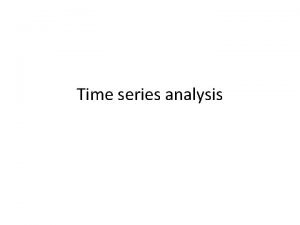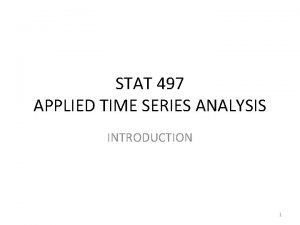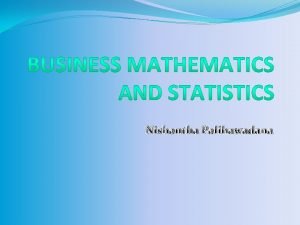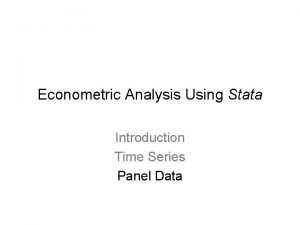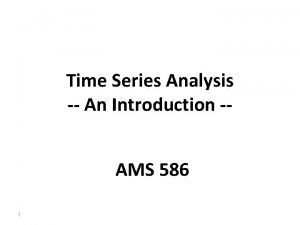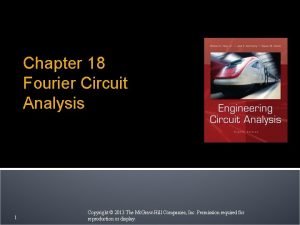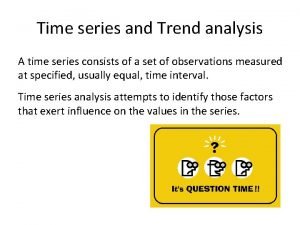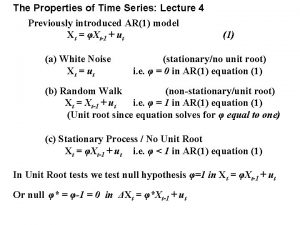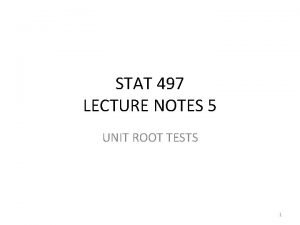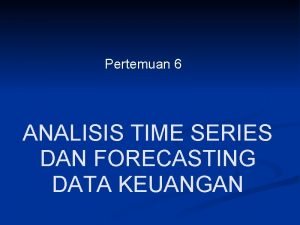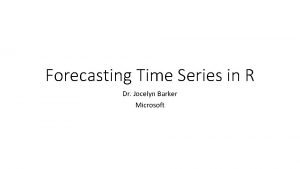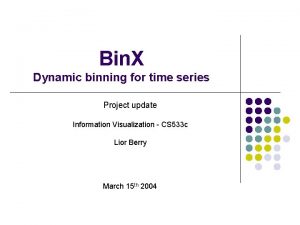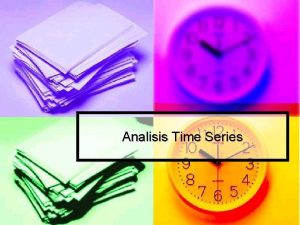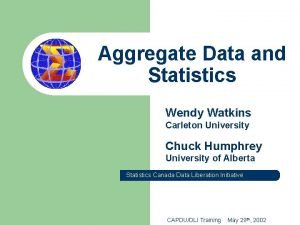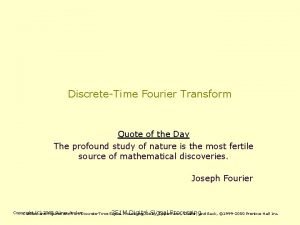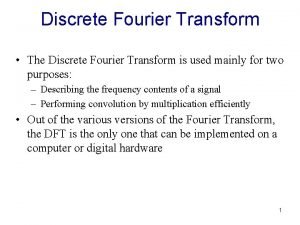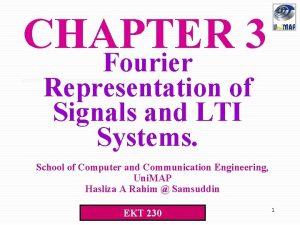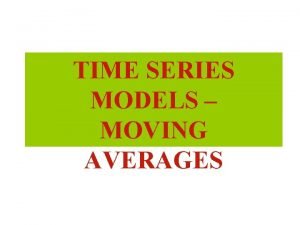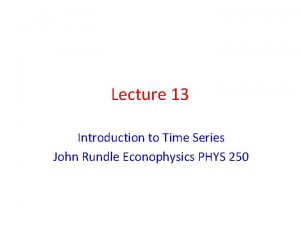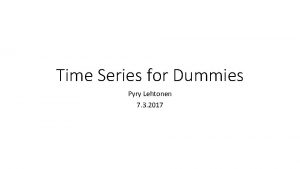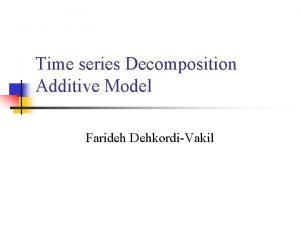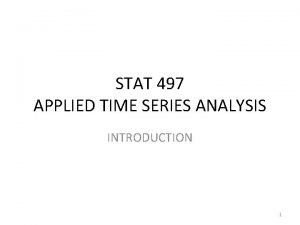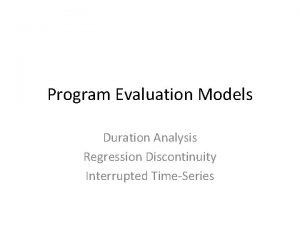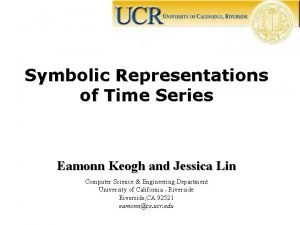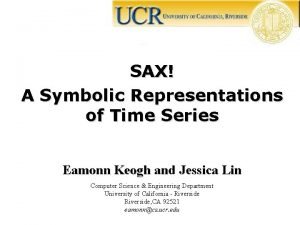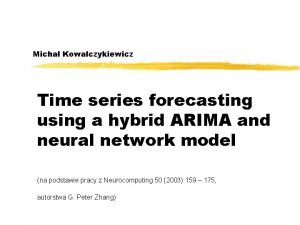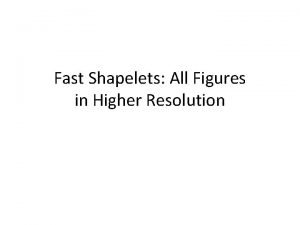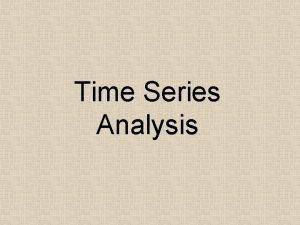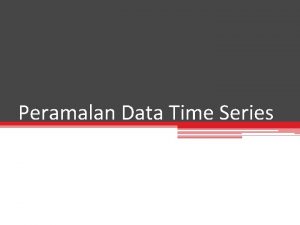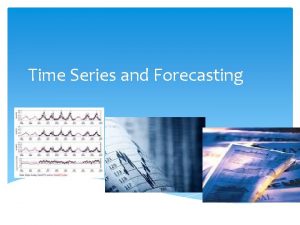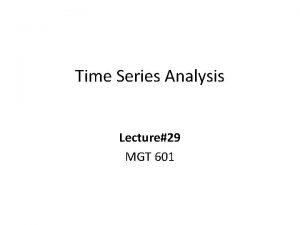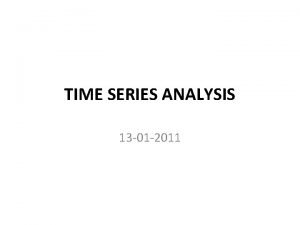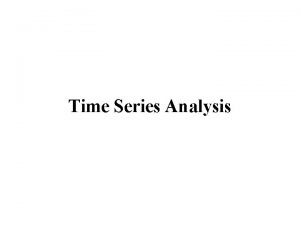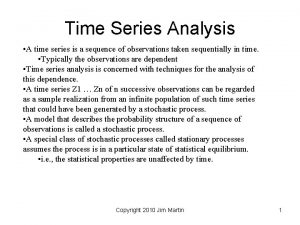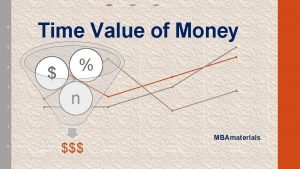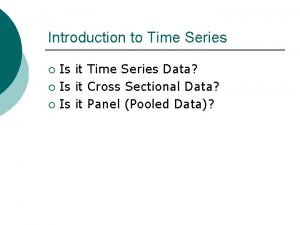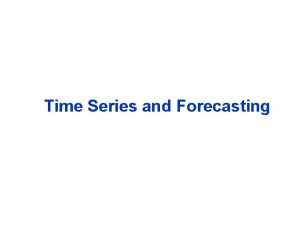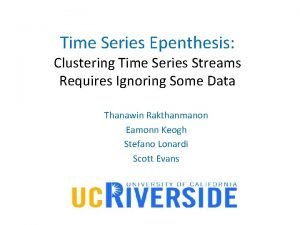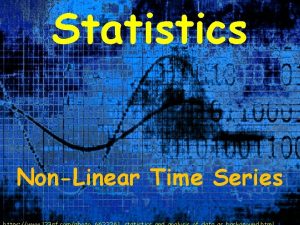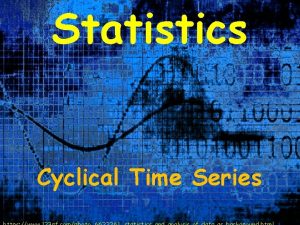Time Series Analysis 1 What is a time





























![An AR(1) Process (ARMA(p=1, q=0)) An autoregressive process of order one [AR(1)] can be An AR(1) Process (ARMA(p=1, q=0)) An autoregressive process of order one [AR(1)] can be](https://slidetodoc.com/presentation_image_h/c7b4c4cdc39a86210319cb11c51cbaac/image-30.jpg)

![An MA(1) Process (ARMA(p=0, q=1)) A moving average process of order one [MA(1)] can An MA(1) Process (ARMA(p=0, q=1)) A moving average process of order one [MA(1)] can](https://slidetodoc.com/presentation_image_h/c7b4c4cdc39a86210319cb11c51cbaac/image-32.jpg)








- Slides: 40

Time Series Analysis 1

What is a time series? A time series is any series of data that varies over time. For example Quarterly GDP of Laos Hourly price of stocks and shares Weekly quantity of beer sold in a pub Each time-series is one realization of a stochastic (i. e. random) process 2

Stationary Time Series Has constant Mean and constant Variance across time Has a theoretical covariance between values of Xt that depends only on the difference apart in time 3


5

6

7

8

Stationary time series WHITE NOISE PROCESS X t = ut ut ~ IID(0, σ2 ) 9

Xt = 0. 5*Xt-1 + ut ut ~ IID(0, σ2 ) 10

Many Economic Series are not stationary Share Prices Exchange Rate Income 11

Non Stationary Time Series There is no long-run mean for the timeseries and/or The variance is time dependent and goes to infinity as time approaches to infinity 12

Spurious Regression The results of classical econometric theory are derived under the assumption that variables of interests are stationary. A Spurious or Nonsensical relationship may result when one Non-stationary time series is regressed on one or more Non-stationary time series. 13

14

An example of Non-stationary time series RANDOM WALK Xt = Xt-1 + ut ut ~ IID(0, σ2 ) Xt = X 0 + u 1 + u 2 +…+ ut Variance: Var(Xt) = Var(X 0) + Var(u 1) +…+ Var(ut) = 0 + σ2 +…+ σ2 = t σ2 (variance is not constant through time) 15

Xt = Xt-1 + ut ut ~ IID(0, σ2 ) 16

17

What is a “Unit Root”? If a Non-Stationary Time Series Xt has to be “differenced” d times to make it stationary, then Xt is said to contain d “Unit Roots”. It is customary to denote Xt ~ I(d) which reads “Xt is integrated of order d” 19

Establishment of Stationarity Using Differencing of Integrated Series If Xt ~ I(1), then Zt = Xt – Xt-1 is Stationary If Xt ~ I(2), then Zt = Xt – Xt-1 – (Xt – Xt-2 ) is Stationary 20

Random Walks A random walk is as a unit root process A random walk process is “integrated of order one, [I(1)], ” meaning a first difference will be stationary, “I(0)”. 21

23

Removing trend and seasonality in a time-series Economic time series often have a trend One possibility to remove a linear trend involves regressing the series on t, which can be modeled as xt = a 0 + a 1 t + et Then analyze the residuals from the detrended series. 24

Seasonality Sometimes time-series data exhibits some seasonality. Example: Quarterly data on retail sales will tend to jump up in the 4 th quarter As with trends, the series can be seasonally adjusted by adding a set of seasonal dummies in the above regression. 25

Alternatively, We can simply remove trend or seasonality by calculating first difference or seasonal difference. 26

A trending series or seasonal series cannot be stationary, since the mean is changing over time. After the adjustment, the remaining maybe stationary and can be analyzed. 27

28

Times-Series Analysis --- (Box-Jenkins Approach analysis, ARIMA analysis) Differencing the series to achieve stationarity Identify model to be tentatively entertained Estimate the parameters of the tentative model No Use the model forecasting Yes Diagnostic checking. Is the model adequate? 29

ARIMA Analysis • We use an autoregressive integrated moving average (ARIMA) model to fit the data. • If time-series data is already stationary, can use autoregressive moving average (ARIMA) model to fit the data. 30

We will use ARMA model to fit a stationary time-series data. ARMA (p, q) refers to a model with p autoregressive terms and q moving average terms. An ARMA (p, q) process is a stationary process in the following form :
![An AR1 Process ARMAp1 q0 An autoregressive process of order one AR1 can be An AR(1) Process (ARMA(p=1, q=0)) An autoregressive process of order one [AR(1)] can be](https://slidetodoc.com/presentation_image_h/c7b4c4cdc39a86210319cb11c51cbaac/image-30.jpg)
An AR(1) Process (ARMA(p=1, q=0)) An autoregressive process of order one [AR(1)] can be characterized as one where xt = rxt-1 + et , t = 1, 2, … with et being an iid sequence with mean 0 and variance se 2 For this process to be stationary, it must be the case that |r| < 1 33

Random Walks A random walk is an AR(1) model where r =1 A random walk series is not stationary. 34
![An MA1 Process ARMAp0 q1 A moving average process of order one MA1 can An MA(1) Process (ARMA(p=0, q=1)) A moving average process of order one [MA(1)] can](https://slidetodoc.com/presentation_image_h/c7b4c4cdc39a86210319cb11c51cbaac/image-32.jpg)
An MA(1) Process (ARMA(p=0, q=1)) A moving average process of order one [MA(1)] can be characterized as one where xt = et + 1 et-1, t = 1, 2, … with et being an iid sequence with mean 0 and variance s 2 e This is a stationary sequence. Variables 1 period apart are correlated, but 2 periods apart they are not. 36

How to choose p and q? Check ACF and PACF graphs • Correlogram – graph showing the ACF and the PACF at different lags. • Autocorrelation function (ACF)- ratio of sample covariance (at lag k) to sample variance • Partial autocorrelation function (PACF) – measures correlation between (time series) observations that are k time periods apart after controlling for correlations at intermediate lags (i. e. , lags less than k). In other words, it is the correlation between Yt and Yt-k after removing the effects of intermediate Y’s. 37

Identifying the model by examining patterns of ACF and PACF Type of Model AR (p) MA (q) ARMA (p, q) Typical Pattern of ACF Typical Pattern of PACF Decays exponentially or Significant spikes with damped sine wave through lags p pattern or both Significant spikes Declines through lags q exponentially Exponential decay 38

39

40

41

Diagnostic Checking—Is our model good enough? How do we know that the model we estimated is a reasonable fit to the data? ü Check residuals after the modeling Rule of thumb: None of the ACF and the PACF are individually statistically significant Formal test: Ljung-Box Q is estimated autocorrelation at lag h. 42

43

Some issues in the time-series modeling üDo not know the underlying cause; we still do not understand why the series is behaving this or that way. üJudgmental decisions on the choice of AR, MA, p, q. Also, model identification requires large number of observations but often times-series data is not very long. üThe model you fitted in past data may not work well in current or future data. 44
 Objectives of time series analysis
Objectives of time series analysis Time series analysis
Time series analysis Time series analysis definition
Time series analysis definition Time series analysis using stata
Time series analysis using stata Importance of time series analysis
Importance of time series analysis What is the component of time series
What is the component of time series Pooled time series
Pooled time series Maclaurin series vs taylor series
Maclaurin series vs taylor series Balmer series lyman series
Balmer series lyman series Maclaurin series vs taylor series
Maclaurin series vs taylor series Taylor frederick
Taylor frederick Ibm p series servers
Ibm p series servers Amount of feedback
Amount of feedback Series aiding and series opposing
Series aiding and series opposing Arithmetic series vs geometric series
Arithmetic series vs geometric series What is elapsed time
What is elapsed time Fourier series circuit analysis
Fourier series circuit analysis 12500x4
12500x4 Unit root time series
Unit root time series Adf.test in r
Adf.test in r Contoh analisis time series
Contoh analisis time series Jocelyn barker
Jocelyn barker Time series binning
Time series binning Pengertian dari data series adalah
Pengertian dari data series adalah Aggregating time series data
Aggregating time series data Time series further maths
Time series further maths Discrete time fourier series
Discrete time fourier series What is discrete fourier transform
What is discrete fourier transform Dtft representation of
Dtft representation of Pengertian forecast penjualan
Pengertian forecast penjualan Corretion
Corretion Spectrum unternet
Spectrum unternet Error correction model
Error correction model Additive model time series
Additive model time series Time series definition
Time series definition Interrupted time series vs regression discontinuity
Interrupted time series vs regression discontinuity Time series motifs
Time series motifs Sax time series
Sax time series Time series forecasting
Time series forecasting Fourier transform of x
Fourier transform of x Time series shapelets
Time series shapelets
